Article Series: Part 1: Organizing & Forming Agile Teams Around Value
A Pattern for enterprise agility, organization design, Team Design Strategy & self-Formation
Welcome to Agile Rising’s blog and Scaled Agile experts! We are here to share our knowledge, experience, and recommendations on how to organize around value using SAFe® as guidance. Our ways are flexible and can be used with other scaling frameworks and patterns with adaptations for jargon and context.
The target audience for these articles are experienced executives, managers, business agility coaches, Agile coaches, SAFe Practice Consultants (SPC), RTEs, and change leaders. If your team is ready to evolve to the next level of leading change and organizing around value, in pursuit of enterprise and business agility, having a frame of reference through experience and knowledge of the Scaled Agile Framework for Lean Enterprises (SAFe), Lean, Scrum, flow concepts, scaling agile, business agility, and organizational change management is helpful.
Our patterns and solutions for organizing around value include critical features of value stream management, SAFe principles, Design Thinking, Agile, organizational change management & design, industrial and organizational psychology, team design strategy, team topologies, team formation & self-selection, and applied Lean and Systems Thinking.
We also introduce the topics of Business Agility Value Streams (BAVS) and managing enterprise value streams through the Value Management Office (VMO) as related to team design strategy and intentional & emergent value stream network design to support business agility. Join us on this journey and evolve your team to the next level of leading change and organizing around value. Let’s pursue enterprise and business agility together!
- Part 1: Organizing & Forming Agile Teams Around Value
- Part 2: What is Team Design Strategy and the Challenges?
- Part 3: Team Design Strategy — Where do we start?
- Part 4: Team Design Strategy — Workshop
- Part 5: Team Self-Selection & Formation Workshop
- Related: Connecting Strategy to Execution with Enterprise Syncs
Goal for new patterns & Workshops
The workshops aim to create an open, inclusive, and psychologically safe space with an invitation to all the system, value stream, and network stakeholders (remembering business agility) to participate and collaborate in the change process through change leadership and intentional design. The collective desired outcome is creating a shared understanding and commitment to a new intentionally designed value stream network and alignment of people into an Agile Release Train (or team of teams).
The achievement of this goal will help fuel the development of new social-business-relational-collaboration networks spanning an entire enterprise scope of operations and enable new ways of working, feeling, and thinking practices and behaviors to cement change in a new system and set of working agreements that the teams will create in their context and system constraints designed to achieve business [or mission] goals and objectives. The activities surrounding the workshops play a pivotal role in your organization’s Digital Strategy and Transformation plans.
The change leadership desired is born out of a focus on relentless improvement while acknowledging the current and prior successes of the recent teams and organizations. Change leaders are responsible for capturing and communicating the “Why?” Leaders must inspire individuals’ innate desire to Survive and enable Thrive mode (Kotter). Existing challenges in the culture with a reductionist mindset must be addressed through inspirational, growth-oriented, and positive leadership, ever pragmatic, designed for the growth and development of people — our most important and valuable asset.
Overview for Organizing & Forming Agile Teams Around Value
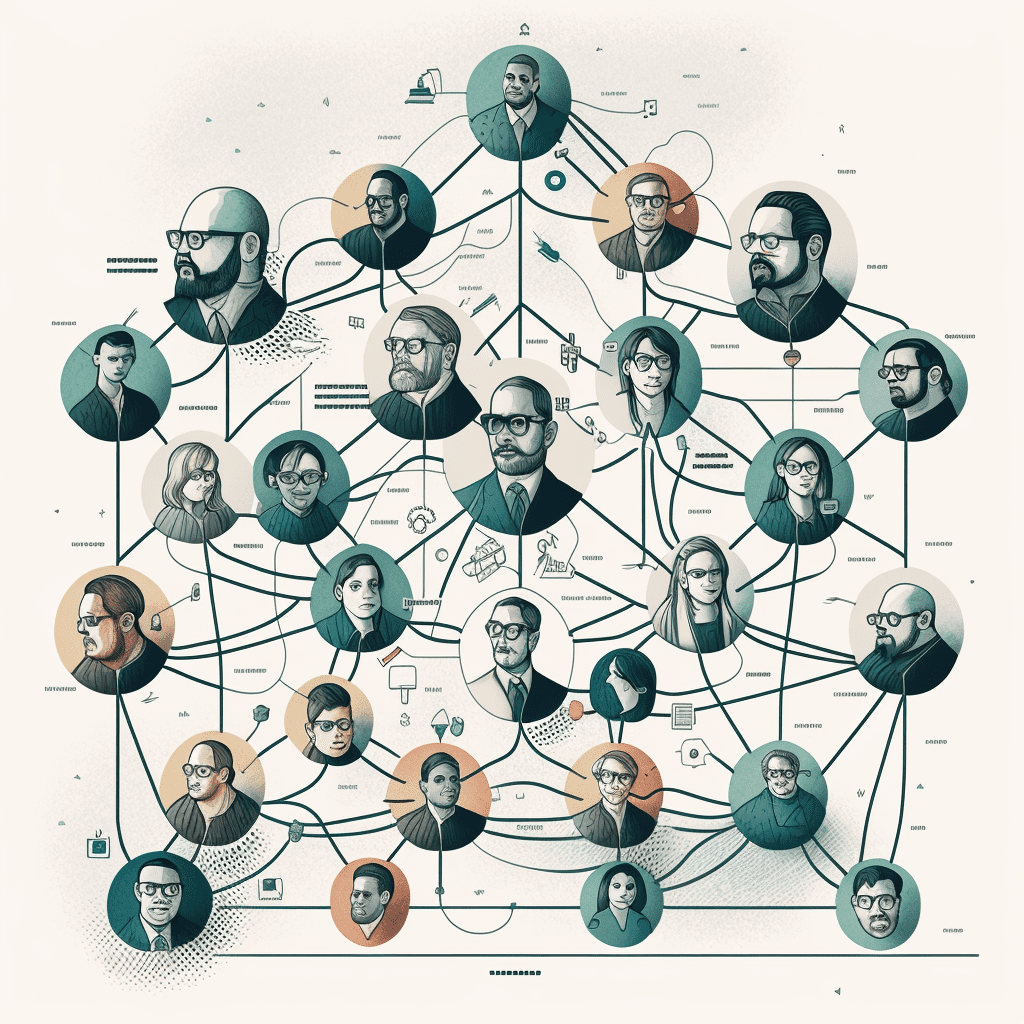
Why do we need new workshops in SAFe?
The current SAFe® Implementation Roadmap is itself an implementation of Kotter’s “Eight-Stage Process of creating Major Change” weaved with Heath’s concept of “scripting the critical moves” from the book “Switch.”
We also must consider communication networks and organizational structure and design beyond the development value stream. Lest the ART and value stream wind up organized in local context of a “sub-stream” of the actual value stream. Conway’s Law helps organizations understand how organization and communication structure often maps directly [a copy] to technology and hardware/software design and patterns the organization produces. This is not an optimized state of design!
Any organization that designs a system (defined broadly) will produce a design whose structure is a copy of the organization’s communication structure.
Melvin Conway
The authors are fond of Martin Fowler’s description of Conway’s Law and we recommend a diversion to read his article. Fowler also introduces the Inverse or Reverse Conway Maneuver, essentially a way to organize for business agility and capabilities.
The guidance in the framework is sound and serves well in many contexts. Still, a more detailed organizational change management plan is needed to manage and lead change successfully in the world’s largest and most complex organizations. The SAFe Implementation Roadmap, like the framework, is incomplete by design. The pattern is very effective, and when combined with expert change agents and consultants, it can help an organization adapt the framework guidance into a successful implementation plan.
To enhance and grow the body of knowledge in the framework to increase organizations’ change success, we propose the addition of two new workshops to your SAFe implementation plan. These additions fit closely within the SAFe Organize Around Value and Create the Implementation Plan growth stages of the roadmap.
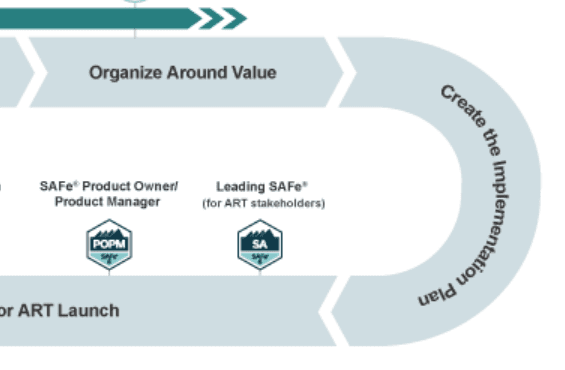
Since we are introducing new concepts for team strategy, design, formation, self-selection, and value stream management, we needed structure to facilitate the critical collaboration and conversations of these concepts at the point of impact of change. To redesign itself, an organization must come together and focus on aligning its strategy, people, and solutions with its entire business or mission by prioritizing organizing around value inclusively and considering the whole value stream (business agility).
The advent of value stream management and flow concepts to SAFe gives movement to the cause of business agility at the enterprise scale [enterprise agility; mission agility]. For the first time in history, we can go to one place to gather and learn key concepts, patterns, and practices to achieve business or mission agility. There is tremendous value in curating many sources of knowledge about agility in one place with a common language. But how do we address complexity at a large scale and transform traditional executive/administrative offices, PMOs, business unit and divisional siloes, management practices, disparate teams, suppliers and vendors, and competing incentives that are all executing on different operating models to take advantage of value stream management and organizing around value and flow?
In Kotter’s words, in summary, this means:
- It is building a case for change that highlights the future benefits of the restructuring [organizing around value in SAFe – designing teams, team formation, and self-selection].
- Engaging employees [and suppliers, vendors, and all stakeholders in the value stream] and accelerating (actual) results. [focusing on outcomes as the actual results rather than vanity metrics, outputs, process or other distractions]
- Reinforcing (and sustaining) the momentum until the work is successful [this is where ADKAR has many incredible benefits.]
A Fresh Look at the Implementing SAFe roadmap
We have also created additional organizational change management activities, including the addition of the Prosci ADKAR Model used in parallel with Kotter’s Eight Stage process in the Agile Rising Customer Journey Map for SAFe. The journey map is an extension of the SAFe Implementation Roadmap that adds change management activities before and after “Go SAFe.” Our journey map pattern includes new workshops, patterns (feedback loops and markers; benchmarking, measuring), and new ideas to accommodate the iterative and incremental nature of actual implementation with PDCA loops.
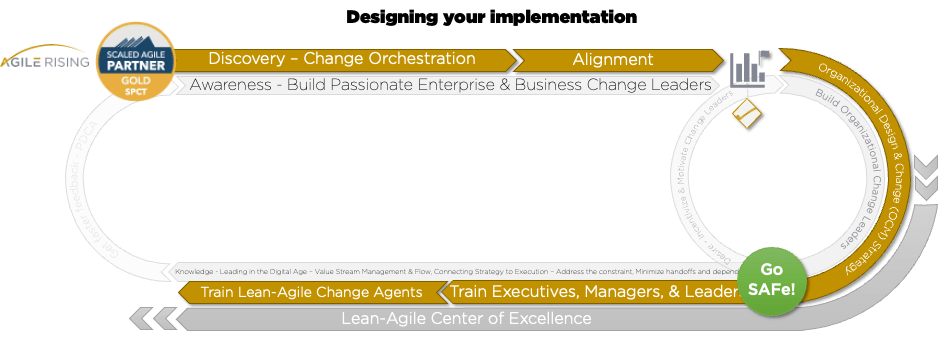
This article series will also articulate and give guidance to avoid the pitfalls that Kotter describes in his book “Change,” where he introduces important ideas around “Restructuring without killing innovation and your future of work.”
the challenge
Our experience is that large, complex organizations generally cannot maintain a consistent pace of change and volume of new concepts introduced over the discovery, design, training, and planning stages of growth into a Lean-Agile Journey [SAFe, digital transformation, or other transformation]. The frenetic pace can, in some cases, result in poorly executed change/implementation plans that leave teams disorganized, disenfranchised, and lacking the necessary energy and focus on accelerating change and improved outcomes while enabling Kotter’s balanced “survive” and “thrive” modes. This results in networks and ARTs that are constrained by these negative experiences:
- Not cross-functional,
- Have poorly formed teams that are also not cross-functional and do not execute as a team,
- Teams experience increased dependencies rather than less dependency,
- A clear lack of intentional and emergent design and architecture of the new system centered on the customer and product with business agility focus
- Failure to recognize the true nature of the scale of the business – its operations – and the consequent operating model inhibits flow and increases waste
- This is most often associated with the anti-pattern of zealots who demand absolute alignment with prescriptions on practice, and failure to focus on principles
- The network and ART structure of the second system is closely coupled to the first system, the hierarchy, and
- Conway’s Law still drives design and architecture causing faulty technical designs and architecture that leads to lower product quality and high technical debt
Systems Thinking has always been a part of the framework [SAFe] guidance and practices. Still, a general singular focus was on development value streams (DVS) in how we planned, orchestrated, and influenced change with the SAFe Implementation Roadmap. When considering organizing around value, SAFe Principle #10, we must consider the entire value stream and system [system of systems]. Organizational Agility, a SAFe core competency, is required as we think about flow and optimization of the whole.
This means thinking beyond the operational and development value streams to include Business Agility Value Streams (BAVS) or Mission Agility Value Streams (MAVS), including the enterprise operating model. The organizational design and operating model pattern of the BAVS accommodates the capability to sense and respond to the market and context rapidly. This intentional design in our pattern for organizing around value also enables the operating model to build true connections between strategy and execution as we will explore in the Systems Model and Goal Setting Framework articles.
Interestingly, Ret. Gen. McChrystal introduces a mission agility value stream concept in his book, “Team of Teams.” He gives real-world examples of how they organized teams around value at the point of impact of change. This made the difference in the military strategic and tactical successes — because the teams had mission agility.
Understanding VUCA
Volatility, uncertainty, complexity and ambiguity or VUCA as it is commonly known describes the world we live in. It is part of a leadership theory and is a way for us to build a framework of references for understanding failure in a system.
Complexity Theory, Systems Thinking, Network, Leadership, and Learning theories all drive decision-making in an organization and the individual, team, and structured process contexts. We introduce the Cynefin Framework or the Stacey Complexity Model as a thinking tool for making decisions across the five domains identified in the framework. This tool is valuable because it gives people patterns to follow that will drive behavior changes within the systems.
There are two important quotes to consider here from Dr. Deming.
If you can’t describe what you are doing as a process, you don’t know what you’re doing.
– Deming
Eighty-five percent of the reasons for failure are deficiencies in the systems and process rather than the employee. The role of management is to change the process rather than badgering individuals to do better.
– Deming
Breaking Bad
We must break out of the technology IT-software-firmware-hardware-centric mindset and consider both upstream, side-stream, and downstream value stream flow for the whole business [or mission] — seeking to enable and achieve true business agility. Indeed software is eating the world. But the rest of the non-software world is still there today. We must accommodate and be inclusive of the whole business.
the solutions
business Agility value streams
The business agility value stream and operational value streams (OVS) are the business. We introduce the business agility value stream to the equation as we expand and capture more end-to-end value streams (chain) and focus on faster response to the market. The BAVS pattern helps organizations apply The Startup Way and science-based management approaches to investment strategy, risk management, and operating models. The business of IT, software, support, services, operations, legal, contracts, finance, and other enterprise functions may all be required to deliver value. Let’s capture them all and organize them around value.
Agile Rising’s solutions for digital transformation include a pillar for Technology Business Management (TBM). Notably, the BAVS transcends the IT, software, and traditional organizational islands and enables value conversations (from TBM). The BAVS captures and focuses the work of the OVS and DVS on opportunity and innovation. In large organizations with IT and Software functions, there is always friction between the business and the technology delivery functions. TBM combined with Lean-Agile practices bridges that gap with new ways and language to communicate and define value for the enterprise. Learn more about TBM from our Agile Rising webinars or TBM course offerings.
New Patterns for Consideration
We must add new thinking tools, patterns, and practices to the SAFe Implementation Roadmap to get started on this advanced learning journey. Agile Rising’s new Customer Journey Map includes many patterns and practices that should be considered as part of the organizational design process.
The Agile Rising Customer Journey Map for SAFe 6.0 adds many new patterns and practices used for designing the implementation and creating a successful change plan. These include:
- Leadership Learning Workshops and Extreme Team Building
- Creating the Value Management Office (VMO)
- Establishing the Critical Measures
- Agile People Operations (HR) Foundations
- Benchmarking
- Innovation Journey Mapping
- Creating the Goal Setting Framework – Capturing and defining goals, strategy, themes & OKRs
- Value Stream Mapping with Flow Framework
- Connection Strategy to Execution with a Systems Model
- Portfolio Design & Strategy Workshop
- Working Agreements, Enterprise Backlog Workshops and Operating Model Identification and Transition Planning
- Proscii ADKAR + Leading with Kotter’s 8 Steps
- Empower Guiding Coalition Members
- LACE Design Thinking
- LACE Exemplar
- Enterprise Retro
- Agile People (HR) & Agile People (HR) Explorer (SAFe)
- Role Overview & Transition Workshops
- Flow Metrics Workshops
- Team Design Strategy Workshops
- Team Formation & Self-Selection Workshops
- Agile Life-cycle Management (ALM) Tooling & Logistics
- Engage ART & Team Coaches
- Preparing the Continuous Delivery Pipeline (CDP)
- Troika ART Launch Retrospective
- RTE, Team Coaches learn Liberating Structures
- Release Optimization
- Identify & Reward Leadership Exemplars
- Professional Coaching Training (IC Agile or ICF)
- Measurable Differentiating Business Outcomes
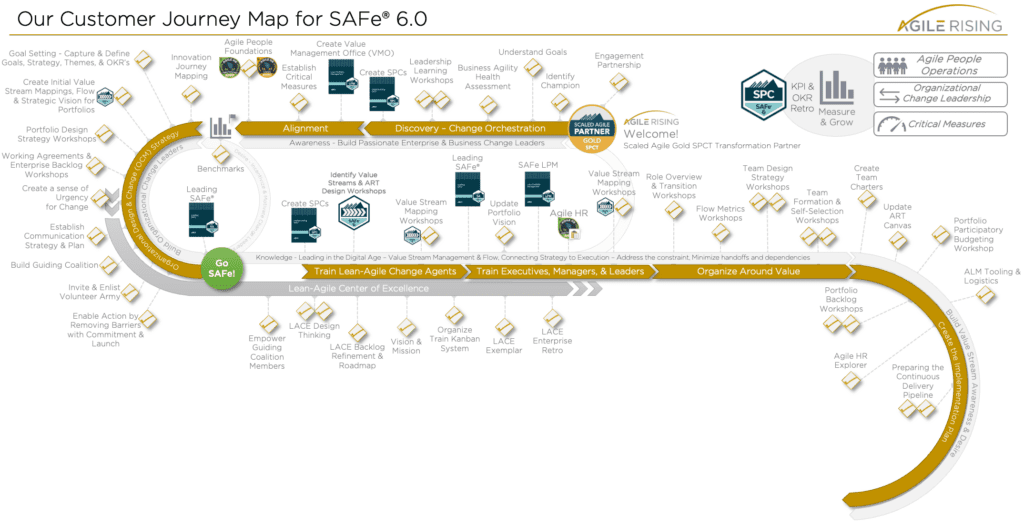
New Workshops and techniques proposed
The new workshops and techniques combined with the new patterns provide time and space for design thinking, innovation, and creativity.
As you will learn in the future series of articles, we will add and adapt Design Thinking and Agile development, as well as Scrum events, into the workshop design patterns for two new proposed SAFe workshops and a derivative for Portfolio Design that are additions to the current implementation roadmap pattern. Value Stream Identification must move beyond the identification of silos and islands from development to include effort and attention toward organizational design for the entire business. We endeavor to optimize the whole.
The Team Design Strategy Workshop (TDSW) and Team Formation & Self-Selection Workshop (SSW) are new collaborations and facilitated workshops developed by Agile Rising for SAFe SPCs to utilize in an organizational change management plan and SAFe Implementation Plan.


We must also change some context within the SAFe Value Stream and ART Identification (VSI) Workshop and make full use (early in the digital transformation) of the SAFe Value Stream Mapping Workshop (VSM).
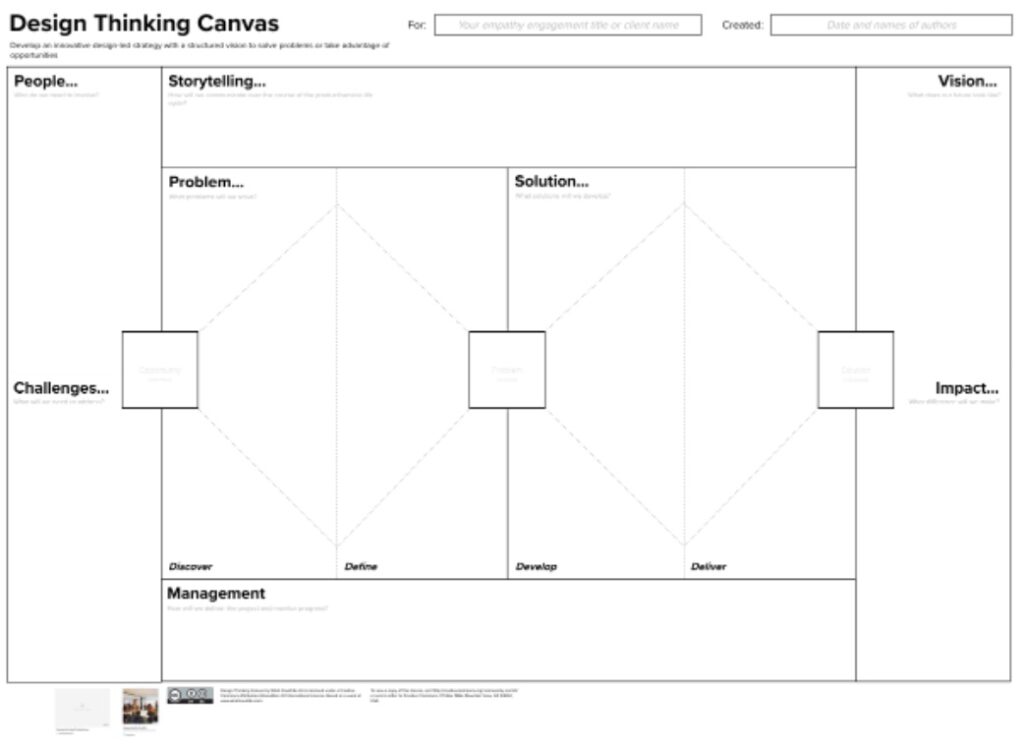
The proposed Agile Rising TDSW and SSW are collaborative team design and self-formation workshop events that utilize Agile [practices; the Manifesto] and Design Thinking to guide and assist in formulating cross-functional Agile teams organized around value. The “value” and “flow” concepts are instructed and defined in the preceding SAFe Value Stream Identification Workshop (VSI). The teams, the people doing the work, and those managing investments will apply in a PDCA feedback loop (or through introductory learning sessions and simulations in most guided transformations using SAFe).
The Design Thinking Canvas is used to facilitate the design thinking process integrated into the pattern. This is accomplished with Agile, iteratively and incrementally, as the system is design-build-tested through run cycles with the feedback loops.
We introduce the concept of Complexity Theory and thinking tools like the Cynefin Framework to help people learn and conceptualize the Second System. Understanding volatility, uncertainty, complexity, and ambiguity (VUCA) is a crucial component in emerging the institutional and organic knowledge of the people who work in the system. They will design the new system collaboratively.
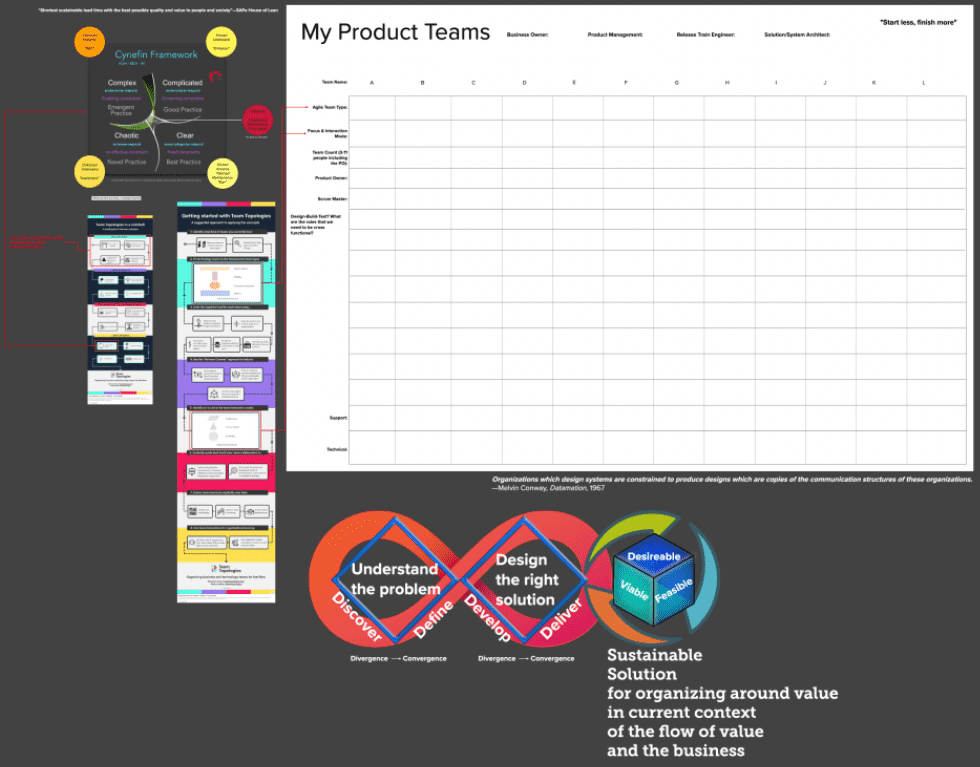
extending Team Topologies
We extend the Team Topologies from the standard platform, complicated sub-system, stream-aligned, and enabling patterns to include business patterns for operations and leadership.
– Agile Rising
The outputs of the traditional SAFe VSI are a notional Agile Release Train (ART) or team of teams, her people groups, and its associated OVS, DVS(s) in the form of a set of business canvases, high-level work-value flows, and loose models of the network. Adding new patterns and workshops allows time and space for designing and constructing business agility teams and time for developing and applying the new topologies for ART and Team patterns. We also extend the Team Topologies from the standard platform, complicated sub-system, stream-aligned, and enabling designs to include business patterns for operations and leadership.
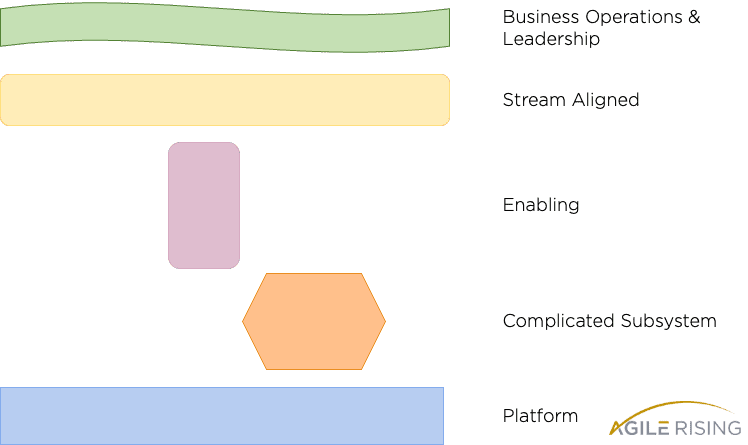
The TDSW and SSW are organized, facilitated, and hosted by the SAFe® Lean-Agile Center of Excellence (LACE) and SPCs.
general digital transformation efforts
It is essential to consider that these workshop patterns can be used for various contexts, even outside of a digital transformation, using SAFe as guidance. Use these collaborative patterns to tackle the challenging service design problems and align your product development organization. There is broad applicability for other scaling frameworks, agile frameworks, practices, models, and common methods. Consultants and coaches can use the workshops and patterns to enable key system design feedback loops.
Equally, it is important to understand the relationship of your “lean and agile transformation” to any general digital transformation initiatives underway in your organization.
What’s next?
Read the next topic article in the series, “What is Team Design Strategy and the Challenges?” where we will learn what Team Design Strategy is and walk through some scenarios to understand the why.
References
Kotter, John, et al. CHANGE : How Organizations Achieve Hard-To-Imagine Results in Uncertain and Volatile Times. S.L., John Wiley, 2021.
Kotter, John P. Leading Change. 1996. Boston, Mass., Harvard Business School Press, 2012.
Heath, Chip, and Dan Heath. Switch. Currency, 16 Feb. 2010.
Scaled Agile, Inc. “SAFe 5.0 Framework.” Scaled Agile Framework, www.scaledagileframework.com. Accessed 22 Feb. 2023.
Prosci. “The Prosci ADKAR® Model.” Www.prosci.com, 2021, www.prosci.com/methodology/adkar.
McChrystal, Stanley A. Team of Teams : The Power of Small Groups in a Fragmented World. London, Portfolio, 2015.
“What Is TBM?” TBM Council, www.tbmcouncil.org/learn-tbm/what-is-tbm/.
VUCA – Volatility, uncertainty, complexity and ambiguity; 1987, based on the leadership theories of Warren Bennis and Burt Nanus
Cynefin Framework – 1999 by Dave Snowden
Technology Business Management (TBM) – 2023, https://www.tbmcouncil.org/learn-tbm/what-is-tbm/
Fowler, Martin, 2022 – Conway’s Law, https://martinfowler.com/bliki/ConwaysLaw.html
Stacey, Ralph – Stacey Complexity Model, https://en.wikipedia.org/wiki/Ralph_D._Stacey
Team Topologies – 2022, teamtopologies.com
Author, co-authors, editors, and reviewers
The following are contributors to this Agile Rising product.
- Marshall Guillory, Author, Scaled Agile SPCT
- Chris Ruch, Co-Author, Scaled Agile SPCT, Editor, and Reviewer
- Kristine O’Conner, Scaled Agile SPC, Editor, and Reviewer
- Tim Schwamb, Scaled Agile SPC, Editor, and Reviewer
